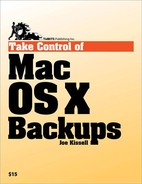If you're using hard drives for backups, you may want to partition the disks. (To decide on partition sizes, review Does Size Matter? earlier.)
Note
Super important!If you'll be using Time Machine, you must follow this procedure, even if you want to end up with only one partition, for disks over 512 GB in size. Such disks were likely partitioned at the factory using the Master Boot Record (MBR) scheme, and Apple's Mac OS Extended format (also known as HFS+) doesn't support MBR-partitioned volumes larger than 512 GB.
To partition a hard disk:
After connecting the drive, launch Disk Utility.
From the list on the left, select the hard disk you want to partition (if a disk has multiple icons, select the topmost, non-indented icon), and click the Partition button on the right.
Under Volume Scheme, choose the number of partitions you want. For each partition, give it a name, and choose a format. Mac OS Extended (Journaled) is the default and recommended choice.
Resize the partitions manually by dragging the dividers, or enter a size for each partition.
Click Options.
In the dialog that appears, select the appropriate partition map scheme. Read USB 2.0 Drives, Intel-Based Macs, and Bootability for more details, but in a nutshell:
If you will use this drive only for Intel-based Macs, select GUID Partition Table.
If you will use it only for PowerPC-based Macs or for both PowerPC- and Intel-based Macs, select Apple Partition Map. Click OK.
When you're happy with your settings, click Partition. You can then quit Disk Utility.
Your hard disk is now partitioned into multiple volumes, each of which will show up in the Finder as an independent disk.
